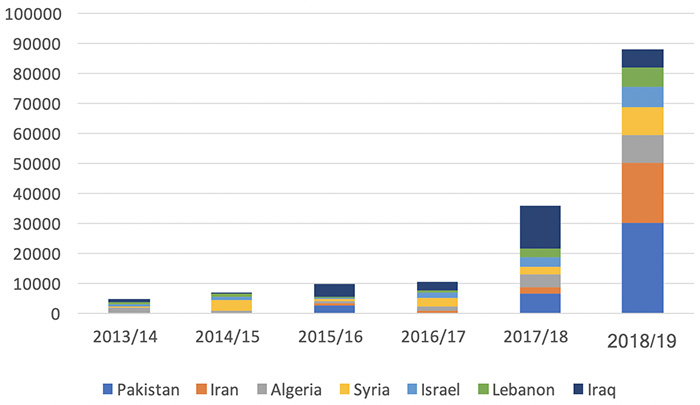November 6, 2019
Drought conditions impacted this year’s crop yields.

Turkey harvests its pulse crops from mid-May through the end of August. This year, dry bean and chickpea yields fell off dramatically from last year, a reflection of the drought conditions that set in during the growing season.
“We had good weather at the start, but then we didn’t get the rainfall we needed,” says Merve Fettahoglu, finance manager at Göze Agricultural Products.
According to the Turkish Statistical Institute, dry bean yields fell from 259 kg/decare in 2018 to 220 this year, a 15% drop off. The decrease in chickpea yields was even more pronounced, falling from 123 kg/decare in 2018 to 92 in 2019, a 25% reduction.
Even so, Turkey harvested 300,000 MT of dry beans this year, a 36% increase over last year.
“Dry bean prices were trending upward and the outlook was bullish at planting, and so growers planted much more beans this year,” explains Fettahoglu.
In the case of chickpeas, the opposite occurred—a downward price trend led growers to reduce the area seeded to chickpeas. Prices were down this planting season due to abundant carry-in stocks. Consequently, given the reduction in area and the low yields, production fell 58% from last year.
Additionally, Turkey typically produces about 300 – 350,000 MT of red lentils and 20 – 30,000 MT of green lentils per year.
“This year, because of yield issues, the red lentil crop will be around 150 – 170,000 MT,” says Fettahoglu.
Usually, Turkey consumes about 85% of its pulse production, with export volumes varying depending on the currency exchange rate and market conditions in a given year. In the case of dry beans, the export volume is negligible, as practically all of the production is consumed internally. Chickpea exports, however, have been trending upward. In the 2016/17 campaign, Turkey exported about 5% of its chickpea crop. But since then, exports have increased to about 20% of production.
According to Turkey’s State Institute of Statistics, the country exported 137,981 MT of chickpeas in 2018/19 (September through August), compared to 67,094 MT in 2017/18 and 21,885 MT in 2016/17. Its top markets this past campaign were Pakistan (30,164 MT) and Iran (20,080 MT).

Source: Turkey’s State Institute of Statistics

Source: Graph based on data from Turkey’s State Institute of Statistics
Disclaimer: The opinions or views expressed in this publication are those of the authors or quoted persons. They do not purport to reflect the opinions or views of the Global Pulse Confederation or its members.